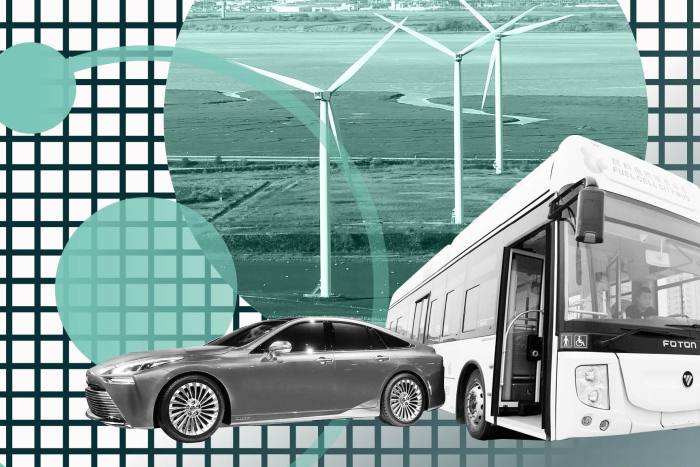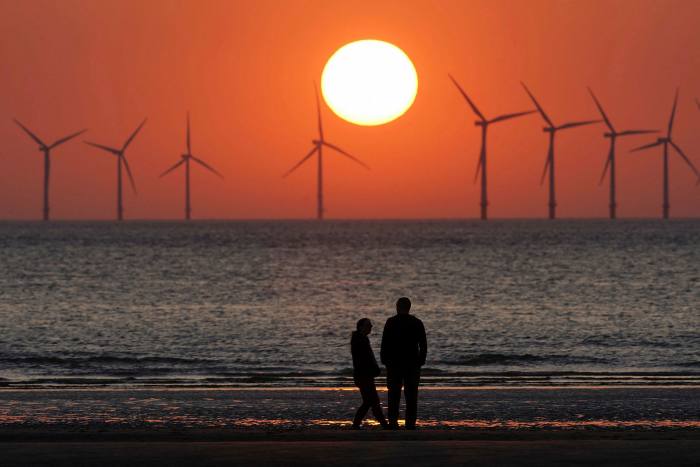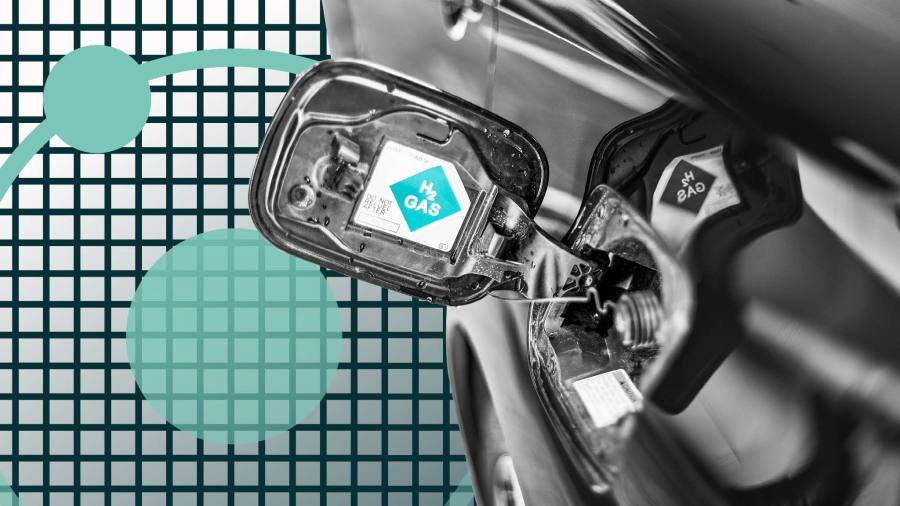[ad_1]
Europe’s two biggest industrial and economic powers are laying billions on the table in an attempt to take on China in developing a “green†hydrogen sector to replace fossil fuels — but the continent’s top motor groups are wary of going along for the ride.
“You won’t see any hydrogen usage in cars,†said Volkswagen chief executive Herbert Diess.
The idea of a big market for vehicles powered by hydrogen fuel cells is “very optimisticâ€, according to Diess, who has overseen a €35bn push into electric cars. “Not even in 10 years,†he told the Financial Times, “because the physics behind it are so unreasonable.â€Â
France and Germany have driven the region’s effort to build a world-leading industry based on the most abundant element in the universe, a pillar of the EU’s plan to achieve carbon neutrality by 2050. Together they have pledged a combined €16bn to hydrogen power generation technologies, the largest direct public investment in the field by EU countries.
Their carmakers, however, remain unconvinced. VW, the world’s second-biggest by sales, has all but abandoned its hydrogen plans. German rival Mercedes, which invested in hydrogen for decades to no avail, quietly shelved its last passenger car fuel cell project last year, while BMW maintains only a toehold in the technology.
France’s PSA, which has bet heavily on electric vehicle technology, also remains deeply sceptical. Carlos Tavares, the outspoken CEO of the recently formed Stellantis group resulting from the merger of Fiat Chrysler with PSA, even suggested to the FT that “most of the people who have pushed for the hydrogen-powered cars are the ones who are late in the electric vehiclesâ€.
The European carmakers’ stance stands in stark contrast to those of their biggest Asian rivals. Japan’s Toyota, the world leader by sales and whose Mirai launched in 2014 was the first mass-produced hydrogen car, and South Korea’s Hyundai continue to invest heavily, bolstered by state incentives and demand from specific customers such as corporate fleets.

Strict EU emissions regulations have instead pushed its carmakers to pour tens of billions of euros into battery technology that provides more certainty, establishing global supply chains and building dedicated electric vehicle platforms to bring down costs.Â
As a rule of thumb, industry executives say that without subsidies carmakers need to sell 100,000 units a year before cost curves start falling. Annual deliveries of hydrogen vehicles in Europe languish in the hundreds.
According to Bernd Heid, a McKinsey analyst, a “ramp-up of both commercial vehicles and passenger cars†powered by hydrogen would be required for the “rapid increase in refilling infrastructure†required to scale up the industry.
However, Renault head of alternative fuels Philippe Prevel said that although hydrogen-powered passenger cars would not be a viable option until 2030 at the earliest, vehicles on fixed routes or closed networks could start to bring costs down before then

Benoit Poitier, chief executive of France’s Air Liquide, one of the biggest and earliest backers of hydrogen, shares Prevel’s view. “Taxis, buses, trains, boats, light commercial vehicles . . . I mean, everything that is flying back to a fixed point or going back to a fixed point is a good candidate,†he said.
Europe’s largest trainmakers have already experimented with the technology. The world’s first hydrogen train trundled through rural Germany in 2018 after being unveiled by France’s Alstom, which argues that for routes of more than 120km hydrogen can be a better solution than batteries. The first hydrogen trains in France will start to roll from 2023.
“Having started in Germany, hydrogen trains are now spreading across Europe and the reason is simple: it’s that all countries are engaged in replacing their fleet of diesel trains and 50 per cent of the rail network in Europe is not electrified,†said Alstom chief executive Henri Poupart-Lafarge. He added that 4,500-5,000 regional diesel trains were up for renewal across Europe.
Siemens in November announced a partnership with Deutsche Bahn to develop a regional hydrogen train that can be refuelled in 15 minutes. The project offers the potential to decarbonise Germany’s 1,300 diesel-powered trains, which are forced to use the fossil fuel on the 40 per cent of the DB network that is not electrified.
“We need to bring our fossil fuel consumption down to zero,†said DB board member Sabina Jeschke, adding that by 2050 the company “won’t have a single diesel-powered train operating in our fleetâ€.
Trucks are a bigger problem to solve. While only accounting for 2 per cent of vehicles on the road in the EU, they are responsible for 22 per cent of road transport carbon emissions, according to pressure group Transport and Environment. And powering them with batteries is not as straightforward an option as it is with cars.
Steve Angel, chief executive of hydrogen pioneer Linde, said large commercial vehicles “can’t afford to sacrifice the payload to accommodate the weight of batteries.â€
Daimler has established a joint venture with arch-rival Volvo to develop hydrogen-powered trucks.
Tavares is also preparing to launch a fleet of trucks powered by hydrogen fuel cells. Those cells are being built by Symbio, a French joint venture with Michelin and Faurecia, which already equips Renault’s hydrogen vans.
While Renault has only sold 200-300 of the first-generation hydrogen Kangoo van since its launch in 2014, it remains cautiously optimistic about the “emerging technologyâ€. It plans to launch two new hydrogen-powered light commercial vehicles in coming months with its new partner, Plug Power.
FT Series: Hydrogen — Fantasy or fuel of the future?

Long heralded as an alternative to fossil fuels, can the gas really help solve the world’s dirtiest energy problems?
But others are dismissive — including VW’s Diess, whose group includes the MAN and Scania truck brands and who once worked on hydrogen projects as an engineer at BMW. He noted that energy is lost converting hydrogen into liquid form — and that the fuel cell itself “has an efficiency of 70 per cent†because it requires a “buffer†battery to transmit its energy to the vehicle.
“You can’t ramp the fuel cell up and down like a combustion engine,†he said. “So you need another 10kW battery, you need an electric engine, and you need to run the fuel cell.â€
The technology, Diess argues, does not even make sense for commercial vehicles. “A truck is really prone to cost per kilometre, load per kilometre and hydrogen is so expensive that you would triple the cost per kilometre against an [electric] truckâ€. Battery-powered trucks could have a range of 200km-300km, he added.
Renault’s Prevel counters that beyond that 300km mark the sheer weight of batteries means hydrogen has a role to play. He would like to see Renault take 30 per cent of the hydrogen light commercial vehicle market, although he acknowledges it is too early to say how big that market will be.
Hydrogen’s credentials as a clean energy source remain an issue, as does the cost of production compared with fossil fuels until the price of renewable energy required to produce it comes down.
Executives who have lived through several hydrogen “hype cycles†remain wary.
“We cannot expect everything to be green and sustainable and our individual behaviours and lives remain the same,†said Christian Bruch, the boss of Germany’s Siemens Energy, which has signed a hydrogen production deal with France’s Air Liquide. “The worst thing that can happen is that we talk about a silver bullet [green hydrogen] that never comes, and it’s always five years away.â€
The colours of the hydrogen rainbow

Green hydrogen Made by using clean electricity from renewable energy technologies to electrolyse water (H2O), separating the hydrogen atom within it from its molecular twin oxygen. Currently very expensive.
Blue hydrogen Produced using natural gas but with carbon emissions being captured and stored, or reused. Negligible amounts in production due to a lack of capture projects.
Grey hydrogen This is the most common form of hydrogen production. It comes from natural gas via steam methane reformation but without emissions capture.
Brown hydrogen The cheapest way to make hydrogen but also the most environmentally damaging due to the use of thermal coal in the production process.
Turquoise hydrogen Uses a process called methane pyrolysis to produce hydrogen and solid carbon. Not proven at scale. Concerns around methane leakage.
Follow @ftclimate on Instagram
[ad_2]
Source link





